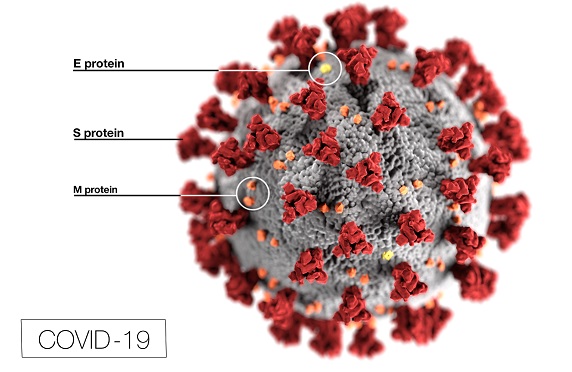
Genetics - those well-informed about the genetics of autism, arthrogryposis, cerebral palsy, Down Syndrome, epilepsy
and other categories of human afflictions can skip this section by clicking here

The genetic material of the now-infamous COVID-19 virus (shown above), like many viruses, is made up of a single strand of RNA. RNA is a long sequence of nucleotides made of ribose, a sugar molecule, attached to a phosphate group and a nitrogen-containing base. The bases used in RNA are adenine (A), cytosine (C), guanine (G), and uracil (U). The bases are interpreted in groups of 3 so there are 64 combinations (4x4x4). The groups code for compounds known as amino acids - there are 61 combinations that resolve as 20 different amino acids. For example, the triple CAG codes for the amino acid glutamine. There are three triples that are known as stop codons: TAA is one of them, and signals that the end of one gene's information has been reached. COVID-19 contains about 29,900 bases, which is comparatively large for a virus. That amounts to about 50 genes that contain information about how to sequence amino acids to build the proteins that make up the virus. There are also genes that describe how to copy the virus. In the case of glutamine a triple of CAA would also code for the same amino acid so the resulting protein would be the same. However, if the first nucleotide were adenine (A) instead of cytosine (C) the resulting amino acid (AAA or AAG) would be lysine instead of glutamine. This is where things get complicated. Sometimes such a change has no particular effect on the resulting protein - other times the protein has reduced or no functionality. As a result of having infected billions of us and having copied huge numbers of viruses there have been more than three thousand (3,582 as of 12/1/2021 per nextstrain.org) known mutations of the COVID virus. Some mutations have produced a virus that is not really a threat, while the delta (Δ) family of variants are somewhat more effective (bad for us humans). An implacable enemy - and certainly not one to be taken lightly. It remains to be seen what impact the emerging omicron (Ο) variants will have.
| Next Page | Prior Page |
| Home | Presentations |